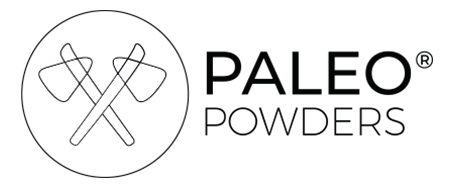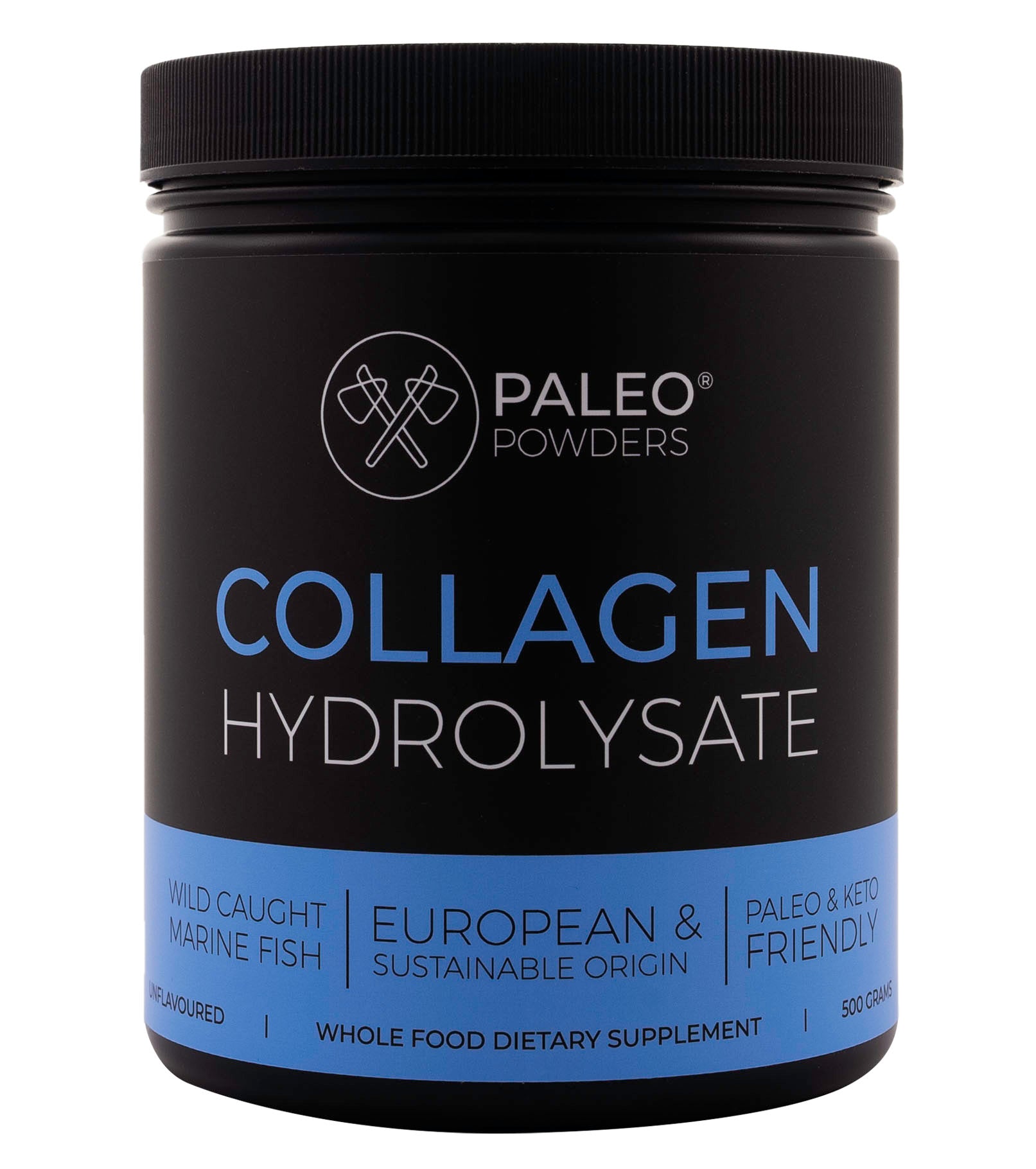
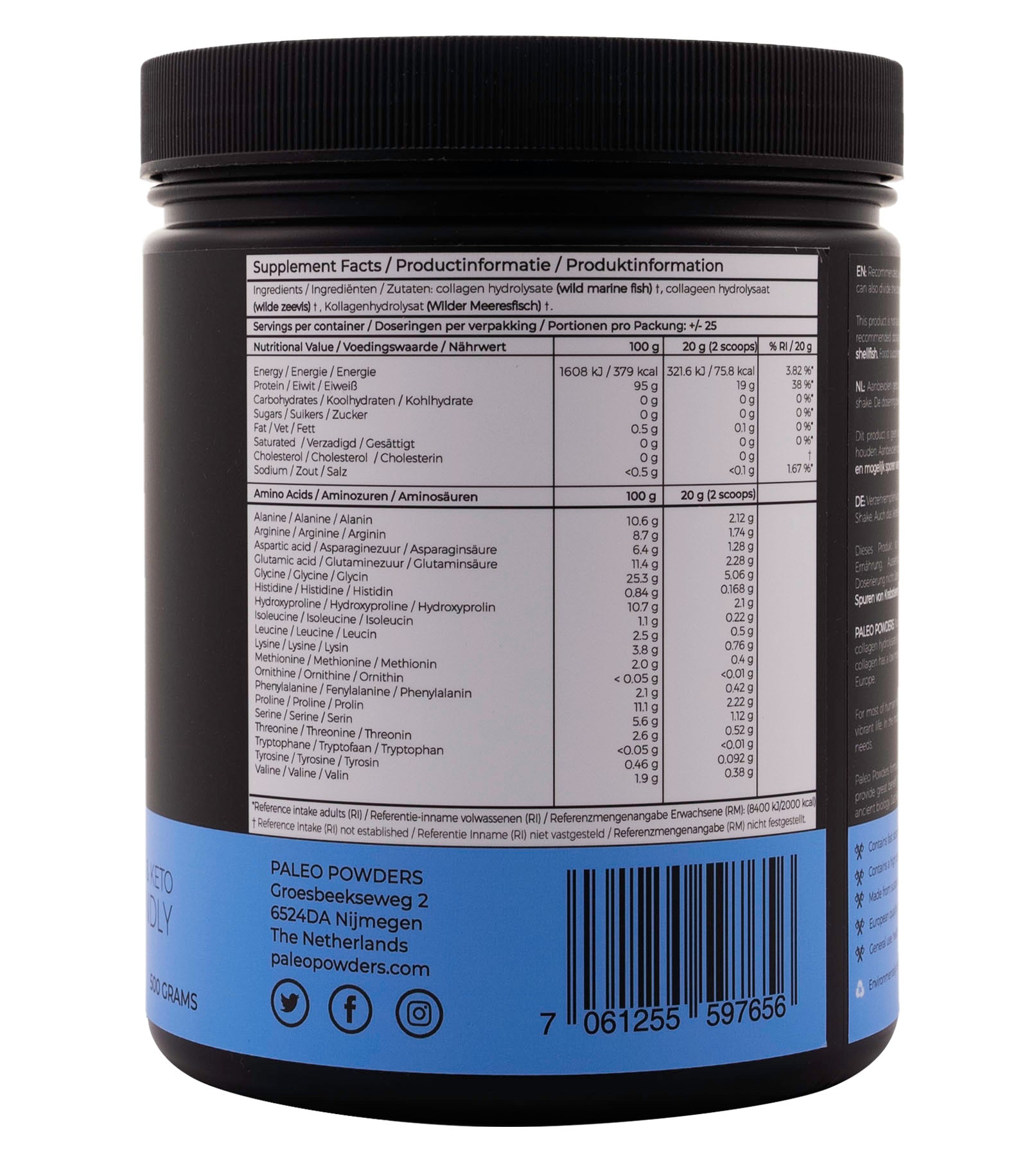
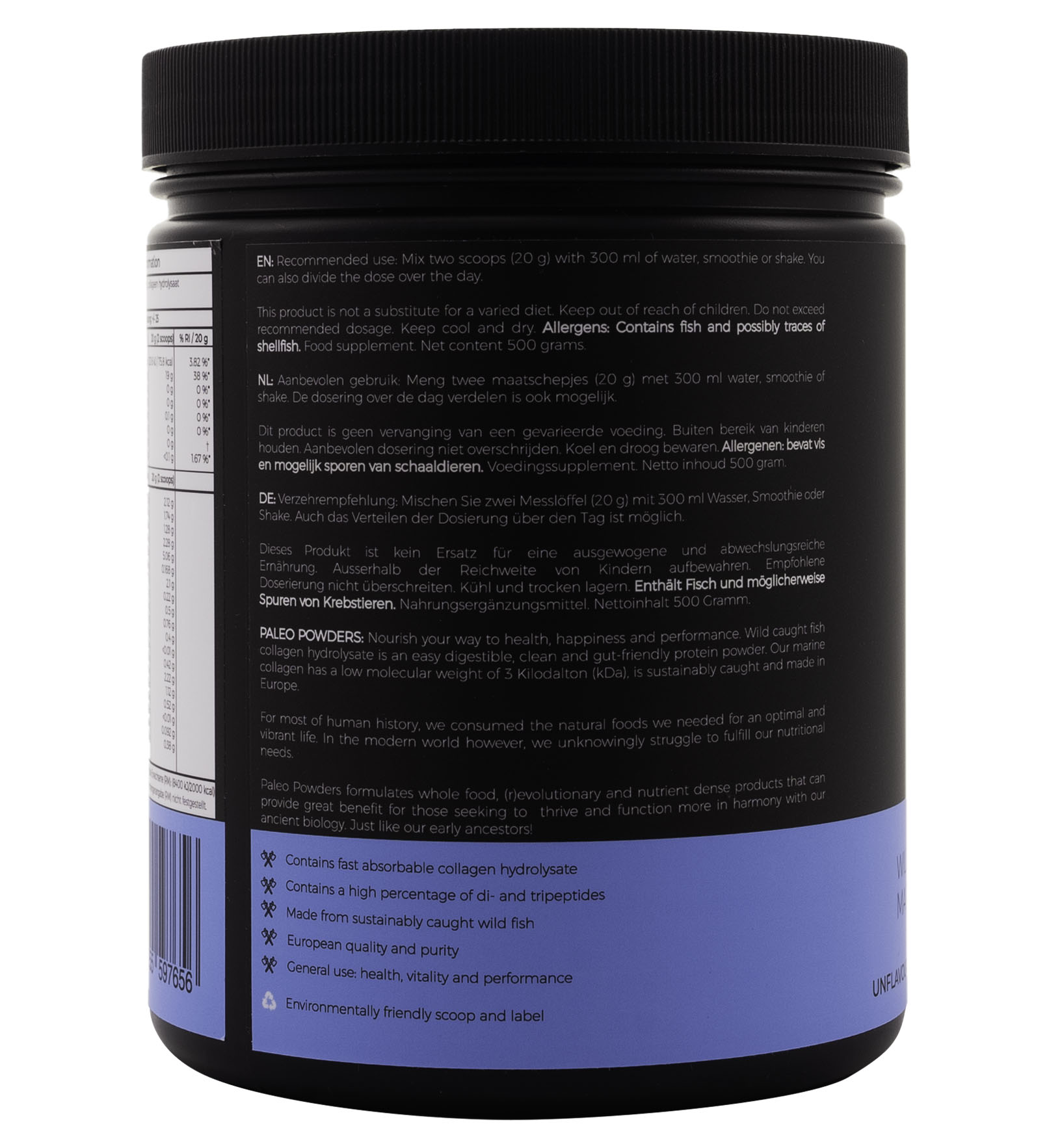
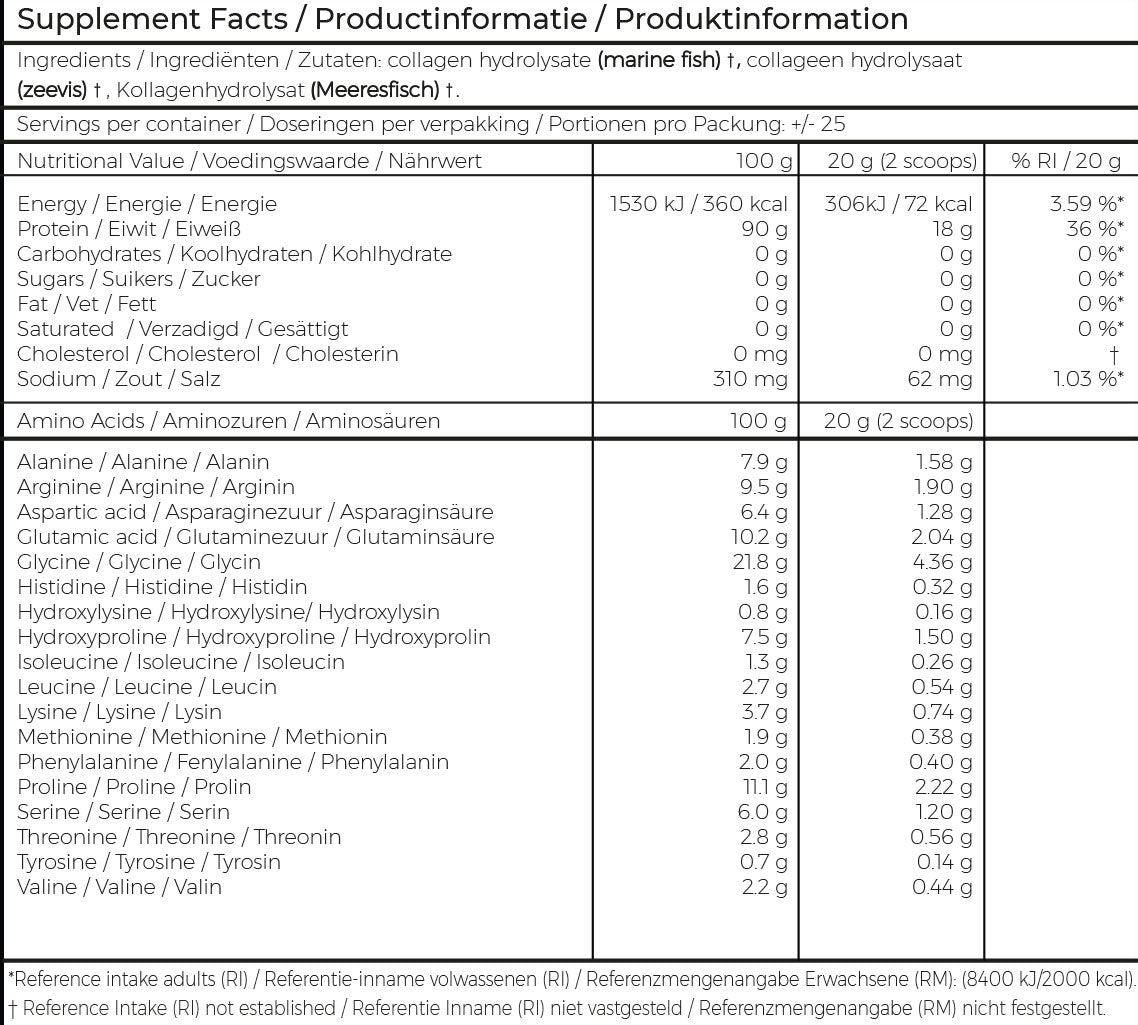

Collagen Hydrolysate - Wild Caught Fish - 500 grams
Tax included.
COLLAGEN HYDROLYSATE FROM WILD FISH
Collagen Hydrolysate is the ultimate all-in-one supplement for your body! The most abundant protein in our body because approximately 25% to 35% of the proteins in our connective tissue, skin, bones and tendons consist of collagen. Collagen Hydrolysate has a specific and unique composition of amino acids that also specifically find their way into the body to your own collagen-rich parts.
Collagen comes from the Greek word "colla" (which means glue) and is found throughout the body, so you can think of it as the "cellular glue" that helps hold all the connective tissues in your body together. Collagen plays a major role in this process of your body and gives strength, firmness and elasticity to the connective tissue in our skin, bones, muscles, tendons, cartilage, nails, teeth and organs, including the entire digestive system. The amino acids in collagen are the building blocks of these structures.
MAINTENANCE FOR THE BODY
Collagen is therefore not just a nutri-cosmetic product but, as mentioned, a true all-in-one superstar for your body. Collagen that you consume through food or supplements naturally increases your body's own collagen supply. The body can produce collagen itself, but from the age of 25 we start to produce less of this important protein until our body produces almost no collagen at the age of 50.
Maintaining good levels and an adequate daily intake of collagen is an interesting part of the nourishing diet that the body is evolutionarily accustomed to.
BENEFITS OF WILD FISH COLLAGEN:
- Neutral taste and odor
- Contains essential amino acids such as glycine, proline and hydroxyproline
- Keto-friendly: contains no added sugars
- Dissolves easily in liquids thanks to natural enzymatic processing
- Rich in collagen type I, an important protein for the skin, bones and joints
- More than 95% protein per serving
- Sourced from Europe, from sustainably wild-caught sea fish
- Available in a handy 500 gram jar, with 25 doses
WHY DO YOU NEED COLLAGEN?
- All tissues in your body, including the body's own collagen, need input and sufficient nutrition to function optimally.
- As you get older, your body's ability to produce collagen decreases.
- Collagen is an important protein that is often missing from the daily diet. Collagen and the specific amino acids bring balance to the protein-amino acid intake. This is specifically due to the L-Methionine and Glycine ratios. Collagen is very rich in the latter.
UPGRADE YOURSELF FROM WITHIN
Increasing your collagen intake is not limited to just nutritional supplements. For example, you can also make bone broth and stews yourself, or eat tougher meat parts instead of fillets. The use of collagen hydrolysate nutritional supplements is above all very practical and time-saving. Collagen hydrolysate from wild cod is an excellent choice for quickly and easily supplementing your daily diet with important amino acids.
GLYCINE, LYSINE & (HYDROXY)PROLINE
Even though collagen hydrolysate does not contain all the essential amino acids, it does contain three amino acids that you cannot find to the same extent in other protein sources. In particular, the high concentrations of glycine, proline and hydroxproline make collagen unique. These three amino acids are only found in small amounts in plant foods. Glycine, proline and hydroxyproline are the three most abundant amino acids in collagen. In the human body you will find these three amino acids in approximately the same ratio as collagen supplements.
KETO AND PALEO APPROVED
Wild fish collagen hydrolysate is made from paleo-approved ingredients from paleo-responsible sources. Because collagen hydrolysate is almost pure proteins, without sugars or fats, it fits into almost any type of diet, from keto to even low fat. Nothing is more nutritious and healthier than products of wild origin. Wild-caught cod from the pure parts of the Atlantic Ocean is no exception. Collagen hydrolysate is very easily digestible and is quickly absorbed, so if you experience problems with your digestion with other protein-rich food sources, trying collagen hydrolysate is a good choice.
100% EUROPEAN ORIGIN
Our collagen peptides are made from wild-caught cod from the Atlantic Ocean fishing area FAO 27 and production only takes place in Europe. This ensures that the quality of the product is controlled and guaranteed from start to finish. Responsibly sourcing our wild fish collagen in Europe increases sustainability compared to purchasing from unreliable sources from, for example, China. Paleo Powders marine collagen is therefore the best choice in terms of quality, sustainability and environmental philosophy.
MADE FROM WILD FISH
By hydrolyzing (cutting into pieces) the collagen proteins from high-quality cod skins in a natural and mild manner with enzymes, peptides are created with a low molecular weight of 3kDa . The taste of the powder is very neutral, making it an ideal ingredient for shakes, smoothies and even recipes. Due to the low molecular weight of the collagen particles, they are absorbed effectively and quickly. With a concentration of up to 95% of proteins per dose, this nutritional supplement is as pure as it can be.
QUALITY MATTERS
Collagen powders are not all of the same quality. In 2020, the Clean Label Project analyzed 30 collagen products for the heavy metals arsenic, cadmium, lead and mercury. The report showed that 100% of collagen supplements tested had mercury levels within safe food standards. However, 34% did contain low measurable concentrations. However, 37% tested positive for high concentrations of lead and 17% tested positive for high concentrations of cadmium.
Animal-friendly and sustainable purchasing solves many of these problems. The said report emphasizes that heavy metal contamination is a by-product of concentrated animal feeding and animal processing. Fortunately, we only choose European wild-caught cod for this product. Another factor that contributes to heavy metal pollution, according to the report, is air pollution. This is unfortunately a fact of the modern world, but can be solved with the right processing technologies.
TESTED FOR HEAVY METALS
Quality control, product safety and transparency are very important to us. That is why we thoroughly screen each analysis certificate and all new batches are analyzed twice in an independent laboratory. This way we ensure quality! The typical values of heavy metals in our collagen hydrolyzate from wild cod:
- Arsenic (As) < 0.10 mg/kg = < 0.1 PPM
- Cadmium (Cd) < 0.01 mg/kg = < 0.01 PPM
- Lead (Pb) < 0.10 mg/kg = < 0.10 PPM
- Mercury (Hg) < 0.005 mg/kg = < 0.005 PPM
DIFFERENCE FISH COLLAGEN, BONE BROTH & KEFIR
|
Fish Collagen |
Bone Broth |
Kefir Whey |
|
Neutral taste |
Mildly savory |
Creamy |
|
Fast absorption |
Normal absorption |
Fast absorption |
|
Hydrolyzed |
Not hydrolyzed |
Semi hydrolyzed |
|
Collagen type I |
Collagen types I to 5 |
No collagen |
|
Enzymatic |
Pulled slowly |
Kefir fermented |
|
95% proteins |
98% proteins |
90% proteins |
|
95% collagen |
78-84% collagen |
0% collagen |
|
No dairy |
No dairy |
Dairy whey |
|
0% fat |
2-5% fat |
0% fat |
|
0% sugars |
0% sugars |
0% sugars |
|
Glycine 21.6% |
Glycine 20% |
Glycine 1.5% |
|
BCAAs 7.42% |
BCAAs 8.4% |
BCAAs 23.75% |
|
Hydroxyproline 10.6% |
Hydroxyproline 10.2% |
Hydroxyproline 0% |
|
From bones |
Fleshy bones |
Meadow milk |
|
No glucosamine |
Contains glucosamine |
No glucosamine |
|
No chondroitin |
Contains chondroitin |
No chondroitin |
|
No hyaluronic acid |
Contains hyaluronic acid |
No hyaluronic acid |
PRIMAL BACKGROUND
Our ancestors from the hunter-gatherer era, and even many generations afterward, ate much more collagen than we do today. This was due to their heavy dependence on animal food. It was not a question of the survival of our ancestors and the survival of our species: whoever managed to catch an animal used the loot from head to toe. Those who wanted to survive ate the entire beast, tendons, cartilage, skins and connective tissues, everything that was healthy; even the bones were consumed or made into tools/weapons. Sea animals or land animals or a combination of both: eating from nose to tail was the norm!
MIGRATION: MORE CARNIVORE EATING
It is known that when hunter-gatherers moved north from the equator, they could eat fewer plants. The colder it got, the fewer plants grew naturally. Since plant foods decrease significantly with increasing latitude, this was compensated with animal foods. Prehistoric hunter-gatherer groups generally obtained about 50% of their diet from animal sources. Modern hunter-gatherer societies obtain approximately 60% of their nutrition from animal sources.
NOSE-TO-TAIL CONCEPT
In prehistoric times, eating only lean muscle meat, without the fats, organs, glands and collagen tissues, would not have been enough to thrive, or even survive. A significant portion of animal food sources would provide nutrient-rich and collagen-rich tissues. In the modern world we generally eat mainly lean muscle meat. We gave up nose-to-tail eating decades ago. Collagen-rich meat or tough meat or other animal parts are no longer preferred today over leaner and more tender meat.
The difference between historical and modern daily collagen consumption is therefore striking. Vegetarians and vegans tend to consume even less collagen than they already do. Based on a paleo perspective, which promotes the nose-to-tail eating concept, it is important to eat enough collagen.
FASCINATING COLLAGEN DYNAMICS
Collagen maintenance and quality depend not only on an adequate daily diet but also on mechanical stress on the body such as sports and exercise. Collagen can quickly change its crystallinity in response to physical forces. For example, the crystallinity and arrangement of collagen molecules in the cartilage in your knees changes with every step you take. Due to the changing mechanical load on each knee during a step, the structural state of the collagen shifts back and forth. The statement "Use it or lose it" applies not only to muscles and bones, but also to collagen tissue. If you do not provide your tissues with the right stimuli, they will lose quality and functionality! Frequent and diverse exercise is part of our human heritage. Fortunately, it's an integral part of a paleo lifestyle.
SYNERGY BETWEEN COLLAGEN & WATER
Water is another important Paleolithic factor relevant to your collagen. After water, collagen is the most abundant substance in your body. In a natural state, collagen contains 60% of its weight from water. Water is therefore an integral part of collagen. Water molecules can adhere tightly to collagen and follow the helix shape neatly and orderly. The complex dynamics of water molecules in hydrated collagen tissue play an important role in determining its structural and functional properties. In other words; good hydration is important for your collagen. Therefore, take good care of the functioning of your mitochondria and drink plenty of pure water every day. Along with exercise and diet, this should be at the top of everyone's list when it comes to collagen health and function.
Hierarchy of health factors
Of course, sleep, grounding, and sensible sunlight exposure are also critical factors that support healthy collagen levels and collagen function throughout the body. Sleep provides a longer period of recovery, while sunlight provides red and near-infrared light, especially around dawn and dusk. Earthing, contact with bare feet on the earth, supplies the connective tissue matrix with electrons from the earth.
THE MOST COMMON PROTEIN
Did you know that there are many types of “most common” proteins in nature? For example, collagen is the most abundant protein in the animal kingdom. There are at least 16 types of collagen, but 80-90% of the collagen in the body is types I, II and III. Actin is the most abundant protein in most eukaryotic cells. It is highly conserved and participates in more protein-protein interactions than any other known protein. These properties make actin a critical player in many cellular functions. In the plant kingdom we find RuBisCO (ribulose-1,5-bisphosphate carboxylase oxygenase). It is considered the most abundant protein in the world because it is present in every plant that undergoes photosynthesis and molecular synthesis during the Calvin cycle. It has been calculated that rubisco constitutes 20-25% of the soluble protein in leaves. It is produced at a rate of about 1000 kg/s on Earth.
Content
Instructions
INGREDIENTS
Choose options





